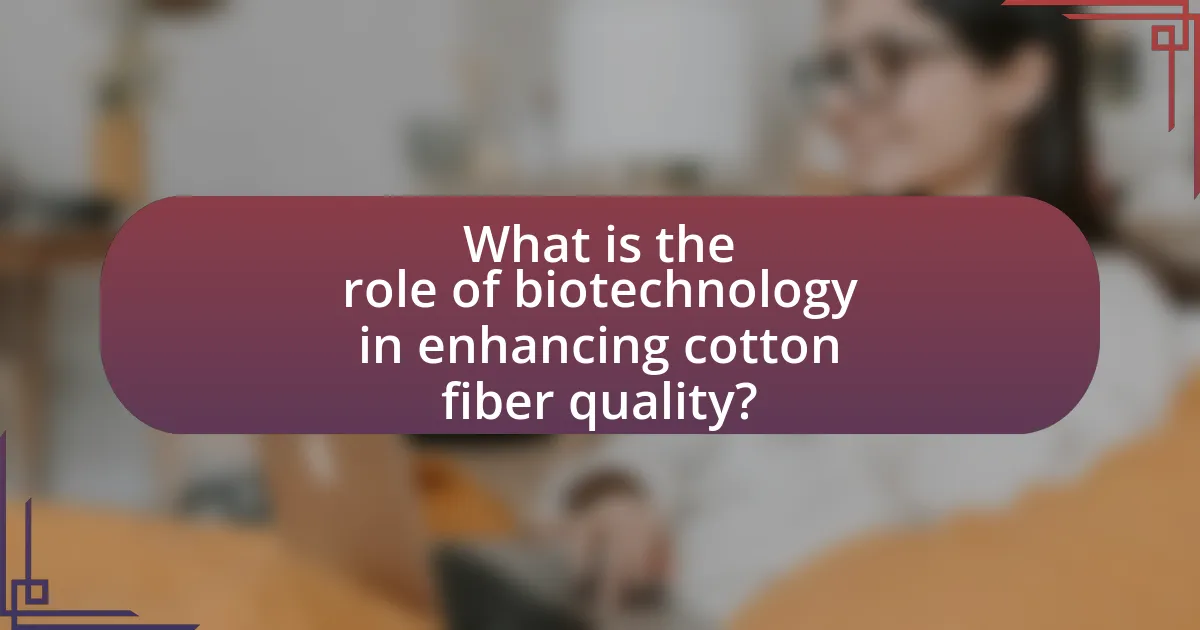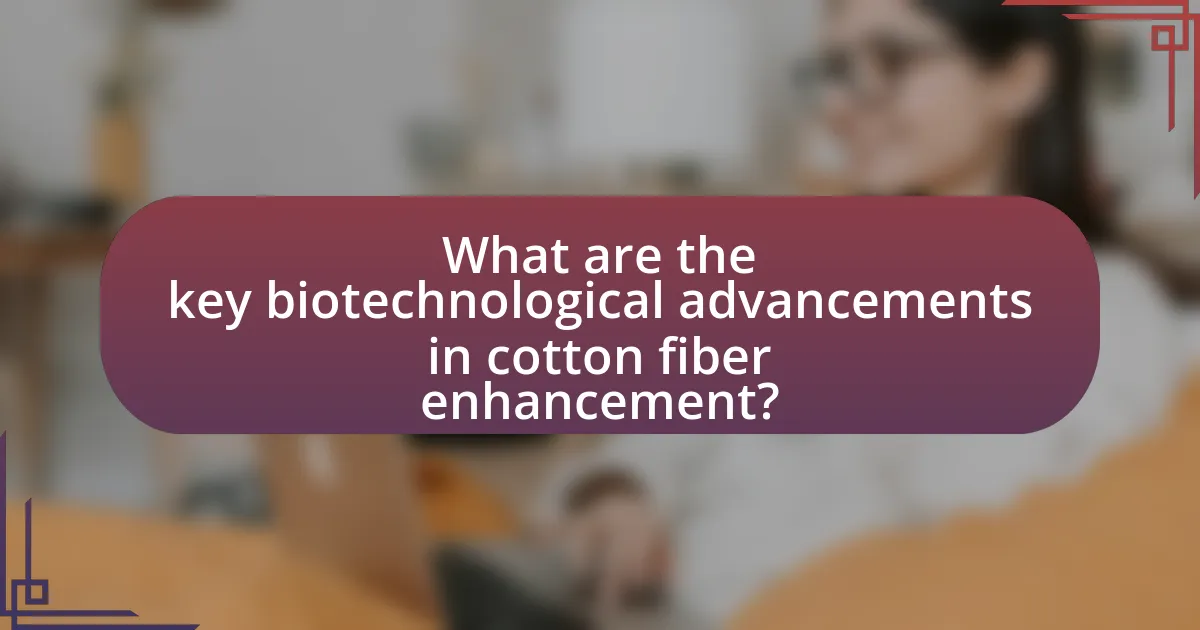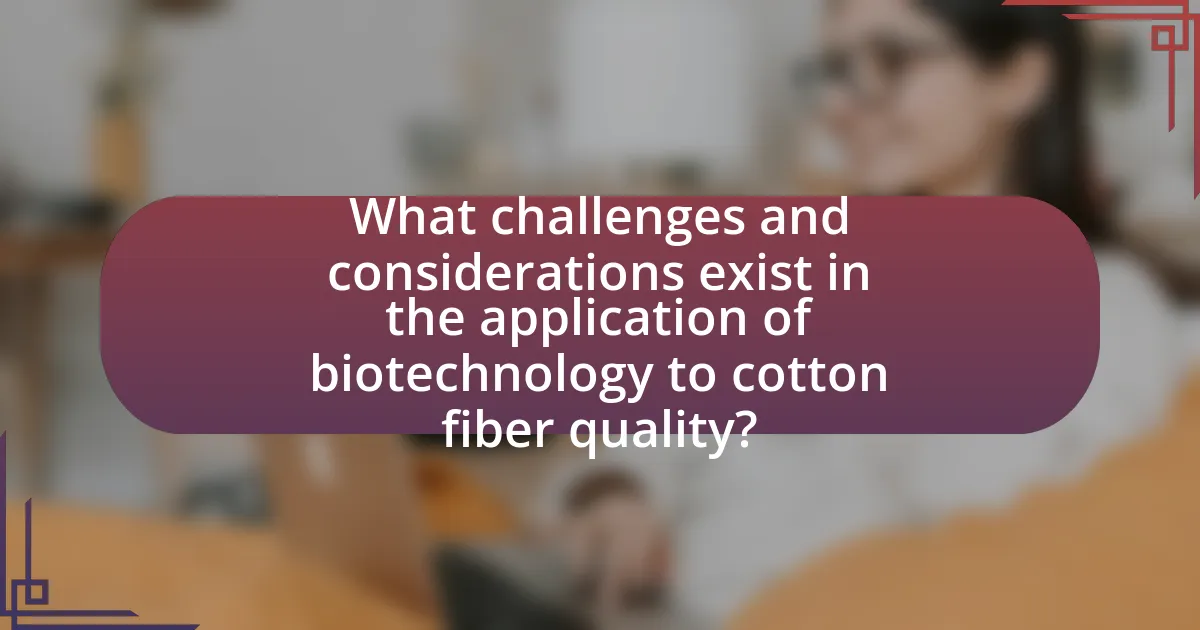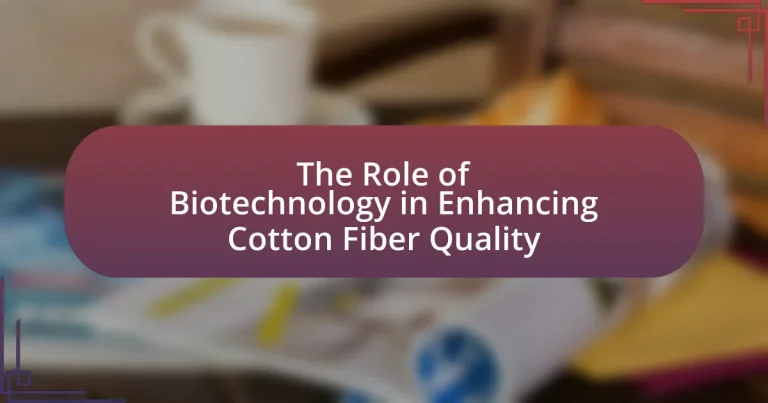Biotechnology plays a pivotal role in enhancing cotton fiber quality through genetic modification and molecular breeding techniques. This article examines how advancements such as transgenic cotton varieties and marker-assisted selection improve fiber traits like strength, length, and resistance to pests, ultimately leading to higher yields and better quality fibers. It also discusses the economic benefits of improved cotton fiber quality for the textile industry, the environmental implications of biotechnological interventions, and the challenges faced in the adoption of these technologies. Key methods, including CRISPR technology and integrated pest management, are highlighted as essential for sustainable cotton production and maximizing the advantages of biotechnology in fiber enhancement.

What is the role of biotechnology in enhancing cotton fiber quality?
Biotechnology plays a crucial role in enhancing cotton fiber quality by enabling the development of genetically modified cotton varieties that exhibit improved traits such as increased fiber strength, length, and uniformity. For instance, research has demonstrated that the introduction of specific genes can enhance the fiber’s tensile strength and reduce susceptibility to pests and diseases, leading to higher yields and better quality fibers. A study published in the journal “Plant Biotechnology Journal” by Zhang et al. (2020) highlighted that transgenic cotton with enhanced fiber quality traits resulted in a 20% increase in fiber strength compared to non-modified varieties. This application of biotechnology not only improves the physical properties of cotton fibers but also contributes to sustainable agricultural practices by reducing the need for chemical inputs.
How does biotechnology contribute to the improvement of cotton fiber properties?
Biotechnology enhances cotton fiber properties primarily through genetic modification and molecular breeding techniques. These methods enable the introduction of specific traits such as increased fiber strength, improved length, and enhanced resistance to pests and diseases. For instance, genetically engineered cotton varieties, like Bt cotton, express a bacterial protein that provides resistance to certain insect pests, leading to higher yields and better fiber quality. Research has shown that these modifications can result in fibers that are not only stronger but also more resilient to environmental stressors, thereby improving overall cotton production efficiency.
What specific biotechnological methods are used to enhance cotton fiber quality?
Biotechnological methods used to enhance cotton fiber quality include genetic engineering, marker-assisted selection, and tissue culture. Genetic engineering allows for the introduction of specific genes that improve fiber strength and length, such as the incorporation of genes from other species that confer desirable traits. Marker-assisted selection utilizes molecular markers linked to fiber quality traits, enabling breeders to select superior cotton varieties more efficiently. Tissue culture techniques facilitate the rapid propagation of high-quality cotton plants, ensuring consistent fiber characteristics. These methods have been validated through various studies, demonstrating significant improvements in fiber properties such as tensile strength and fineness.
How do genetic modifications impact cotton fiber characteristics?
Genetic modifications significantly enhance cotton fiber characteristics by improving traits such as fiber length, strength, and fineness. For instance, genetically engineered cotton varieties, like Bt cotton, have been developed to resist pests, which allows for better growth conditions and ultimately leads to longer and stronger fibers. Research indicates that these modifications can increase fiber yield by up to 30% and improve fiber strength by 10-20%, as demonstrated in studies conducted by the International Cotton Advisory Committee. These enhancements contribute to higher quality cotton that meets market demands more effectively.
Why is enhancing cotton fiber quality important for the textile industry?
Enhancing cotton fiber quality is crucial for the textile industry because it directly impacts the performance, durability, and aesthetic appeal of textile products. High-quality cotton fibers result in stronger, softer, and more resilient fabrics, which are essential for meeting consumer demands and maintaining competitiveness in the market. According to the International Cotton Advisory Committee, improved fiber quality can lead to a 10-20% increase in the value of cotton, demonstrating its economic significance. Additionally, advancements in biotechnology, such as genetic modification and selective breeding, have been shown to enhance fiber traits like length, strength, and fineness, further solidifying the importance of quality enhancement in cotton production.
What economic benefits arise from improved cotton fiber quality?
Improved cotton fiber quality leads to significant economic benefits, including higher market prices and increased profitability for farmers. Higher quality cotton fibers are more desirable in the textile industry, resulting in premium pricing; for instance, high-quality cotton can command prices up to 20% higher than lower-quality alternatives. Additionally, enhanced fiber quality reduces production costs for manufacturers by minimizing waste and improving processing efficiency, which can lead to a 10-15% reduction in production costs. These factors collectively contribute to a more robust cotton industry, fostering economic growth in regions reliant on cotton production.
How does fiber quality affect consumer preferences and market demand?
Fiber quality significantly influences consumer preferences and market demand by determining the perceived value and usability of cotton products. High-quality fiber, characterized by attributes such as strength, length, and fineness, leads to greater consumer satisfaction and loyalty, as consumers often associate these qualities with durability and comfort. For instance, research indicates that consumers are willing to pay a premium for cotton products made from superior fiber, which can enhance brand reputation and market share. Additionally, market trends show that brands emphasizing high fiber quality experience increased demand, as evidenced by the rise in sales of premium cotton apparel, which often highlights the benefits of enhanced fiber quality through biotechnology advancements.

What are the key biotechnological advancements in cotton fiber enhancement?
Key biotechnological advancements in cotton fiber enhancement include the development of genetically modified cotton varieties that exhibit improved fiber quality, increased yield, and resistance to pests and diseases. For instance, the introduction of Bt cotton, which expresses a bacterial protein that is toxic to specific pests, has significantly reduced the need for chemical pesticides and improved fiber quality by allowing plants to allocate more resources to fiber production. Additionally, advancements in marker-assisted selection have enabled breeders to identify and select for traits associated with superior fiber characteristics, such as length, strength, and fineness, leading to the development of high-quality cotton varieties. Research published in the journal “Plant Biotechnology Journal” highlights the successful application of CRISPR technology to enhance fiber traits by precisely editing genes associated with fiber development, demonstrating the potential for targeted improvements in cotton fiber quality.
What role do transgenic cotton varieties play in fiber quality improvement?
Transgenic cotton varieties significantly enhance fiber quality by incorporating specific genes that improve traits such as strength, length, and uniformity. These genetically modified varieties often exhibit increased resistance to pests and diseases, which leads to healthier plants and better fiber production. For instance, the introduction of the Bt gene in transgenic cotton has been shown to reduce the need for chemical pesticides, resulting in higher fiber yield and quality due to less stress on the plants. Research indicates that transgenic cotton can produce fibers with improved tensile strength and finer diameter, which are critical factors for textile manufacturing. Studies have demonstrated that these varieties can yield fibers with a higher micronaire value, indicating better spinning performance and overall quality in the final textile products.
How do specific genes influence fiber strength and length?
Specific genes influence fiber strength and length by regulating the synthesis of structural proteins and cell wall components in cotton fibers. Genes such as GhMYB25 and GhEXP1 have been identified to play crucial roles in fiber development; GhMYB25 is associated with fiber elongation, while GhEXP1 is linked to cell wall expansion. Research indicates that the expression levels of these genes directly correlate with the mechanical properties of the fibers, where higher expression leads to increased fiber strength and length. For instance, a study published in the journal “Plant Biotechnology Journal” by Zhang et al. (2017) demonstrated that transgenic cotton plants overexpressing GhMYB25 exhibited significantly longer and stronger fibers compared to wild-type plants, confirming the genetic influence on fiber quality.
What are the environmental implications of using transgenic cotton?
The environmental implications of using transgenic cotton include reduced pesticide use, increased biodiversity, and potential risks of gene transfer to wild relatives. Transgenic cotton, engineered for pest resistance, has led to a significant decrease in chemical pesticide applications, with studies showing a reduction of up to 50% in some regions, which benefits non-target organisms and overall ecosystem health. Additionally, the cultivation of transgenic cotton can enhance biodiversity by allowing for more sustainable farming practices. However, there are concerns regarding the potential for transgenic traits to transfer to wild cotton species, which could disrupt local ecosystems and lead to unintended consequences. Research indicates that monitoring and management strategies are essential to mitigate these risks while maximizing the environmental benefits of transgenic cotton.
How does molecular breeding contribute to cotton fiber enhancement?
Molecular breeding significantly enhances cotton fiber quality by enabling the precise selection of desirable traits at the genetic level. This technique utilizes molecular markers linked to fiber characteristics such as length, strength, and fineness, allowing breeders to identify and propagate superior cotton varieties more efficiently. For instance, research has shown that molecular breeding can increase fiber strength by up to 20% through the identification of specific genes associated with this trait. Additionally, molecular breeding facilitates the introduction of resistance to pests and diseases, which indirectly contributes to improved fiber quality by reducing crop stress and enhancing overall plant health.
What techniques are involved in molecular breeding for cotton?
Molecular breeding for cotton involves techniques such as marker-assisted selection (MAS), genetic transformation, and genome editing. Marker-assisted selection utilizes molecular markers linked to desirable traits, allowing breeders to select plants with specific genetic profiles more efficiently. Genetic transformation introduces new genes into cotton plants to enhance traits like pest resistance or fiber quality. Genome editing, particularly through CRISPR/Cas9 technology, enables precise modifications to the cotton genome, facilitating the development of varieties with improved characteristics. These techniques collectively enhance the efficiency and effectiveness of breeding programs aimed at improving cotton fiber quality.
How does molecular breeding compare to traditional breeding methods?
Molecular breeding is more precise and efficient than traditional breeding methods. While traditional breeding relies on the selection of phenotypic traits over multiple generations, molecular breeding utilizes genetic markers to identify and select desirable traits at the DNA level, significantly speeding up the process. For instance, molecular techniques can reduce the time required to develop new cotton varieties with improved fiber quality from several years to just a few seasons, as demonstrated in studies where marker-assisted selection led to faster development of high-yielding, disease-resistant cotton varieties. This precision not only enhances the quality of cotton fibers but also allows for targeted improvements, minimizing the risk of unintended traits being introduced, which is a common issue in traditional breeding.

What challenges and considerations exist in the application of biotechnology to cotton fiber quality?
The application of biotechnology to cotton fiber quality faces several challenges and considerations, including genetic variability, regulatory hurdles, and environmental impacts. Genetic variability is crucial as it affects the ability to enhance fiber traits such as strength and length; limited genetic diversity can restrict progress. Regulatory hurdles arise from the need for extensive testing and approval processes for genetically modified organisms, which can delay the introduction of improved cotton varieties. Environmental impacts must also be considered, as biotechnological interventions may affect local ecosystems and biodiversity. These challenges necessitate a careful approach to ensure that biotechnology effectively enhances cotton fiber quality while addressing potential risks.
What are the potential risks associated with biotechnological interventions in cotton?
Biotechnological interventions in cotton pose several potential risks, including environmental impacts, loss of biodiversity, and health concerns. These interventions, such as genetically modified organisms (GMOs), can lead to unintended consequences like the development of resistant pests and weeds, which may disrupt local ecosystems. Additionally, the reliance on specific biotechnological traits can reduce genetic diversity within cotton crops, making them more vulnerable to diseases and climate change. Studies have indicated that the introduction of GM cotton can also raise concerns about allergenicity and long-term health effects on consumers, as seen in research published by the National Academy of Sciences.
How do regulatory frameworks impact the adoption of biotechnological cotton?
Regulatory frameworks significantly influence the adoption of biotechnological cotton by establishing guidelines for safety, environmental impact, and market access. These frameworks determine the approval processes for genetically modified organisms (GMOs), which can either facilitate or hinder the introduction of biotechnological cotton varieties. For instance, countries with stringent regulations may delay the commercialization of biotechnological cotton, impacting farmers’ ability to access improved seed varieties that enhance fiber quality and yield. In contrast, regions with supportive regulatory environments often see quicker adoption rates, as evidenced by the rapid increase in biotech cotton cultivation in countries like the United States and India, where regulatory processes are more streamlined.
What public perceptions influence the acceptance of biotechnological cotton products?
Public perceptions that influence the acceptance of biotechnological cotton products include concerns about health, environmental impact, and ethical considerations. Research indicates that consumers often associate genetically modified organisms (GMOs) with potential health risks, leading to skepticism about biotechnological cotton. Additionally, perceptions regarding the environmental sustainability of biotechnological practices, such as reduced pesticide use and improved water efficiency, can enhance acceptance among environmentally conscious consumers. Ethical concerns, including the implications of corporate control over seeds and farming practices, also play a significant role in shaping public attitudes. Studies show that informed consumers who understand the benefits of biotechnology, such as increased yield and fiber quality, are more likely to accept biotechnological cotton products.
How can stakeholders ensure sustainable practices in biotechnological cotton production?
Stakeholders can ensure sustainable practices in biotechnological cotton production by implementing integrated pest management (IPM) strategies, promoting water-efficient irrigation techniques, and utilizing genetically modified organisms (GMOs) that require fewer chemical inputs. IPM reduces reliance on pesticides, thereby minimizing environmental impact and promoting biodiversity. Water-efficient irrigation, such as drip irrigation, conserves water resources, which is critical in cotton farming due to its high water consumption. Additionally, GMOs can be engineered for pest resistance and drought tolerance, leading to reduced chemical usage and improved resilience to climate change. These practices collectively contribute to sustainable cotton production while enhancing fiber quality.
What best practices should be followed in biotechnological cotton cultivation?
Best practices in biotechnological cotton cultivation include selecting genetically modified (GM) cotton varieties that are resistant to pests and diseases, implementing integrated pest management (IPM) strategies, and utilizing precision agriculture techniques for optimal resource use. GM cotton varieties, such as Bt cotton, have been shown to reduce pesticide use by up to 50% while maintaining high yields, as evidenced by studies from the International Service for the Acquisition of Agri-biotech Applications (ISAAA). Additionally, IPM strategies combine biological, cultural, and chemical practices to manage pest populations sustainably, enhancing both crop health and fiber quality. Precision agriculture, which employs technology for soil and crop monitoring, allows for targeted interventions that improve water and nutrient efficiency, further contributing to the overall success of biotechnological cotton cultivation.
How can collaboration among stakeholders enhance the benefits of biotechnology in cotton?
Collaboration among stakeholders can significantly enhance the benefits of biotechnology in cotton by facilitating knowledge sharing, resource allocation, and coordinated research efforts. When farmers, researchers, agribusinesses, and policymakers work together, they can identify specific challenges in cotton production and develop targeted biotechnological solutions, such as pest-resistant or drought-tolerant cotton varieties. For instance, the collaboration between seed companies and agricultural research institutions has led to the development of genetically modified cotton that improves yield and fiber quality, as evidenced by the increased adoption of Bt cotton, which has been shown to reduce pesticide use by up to 50% while increasing yields by 20-30%. This synergy not only accelerates innovation but also ensures that the benefits of biotechnology are effectively communicated and implemented at the farm level, ultimately leading to sustainable agricultural practices and enhanced economic viability for cotton producers.
What practical tips can be implemented for maximizing the benefits of biotechnology in cotton fiber quality?
To maximize the benefits of biotechnology in cotton fiber quality, implement genetic modification techniques to enhance traits such as fiber strength and length. Utilizing CRISPR technology allows for precise editing of cotton genomes, leading to improved resistance to pests and diseases, which in turn can enhance fiber quality. Research indicates that genetically modified cotton varieties can produce fibers with up to 20% greater strength compared to non-modified counterparts, as demonstrated in studies published in the Journal of Cotton Science. Additionally, integrating biotechnological advancements in nutrient management can optimize growth conditions, further improving fiber characteristics.





